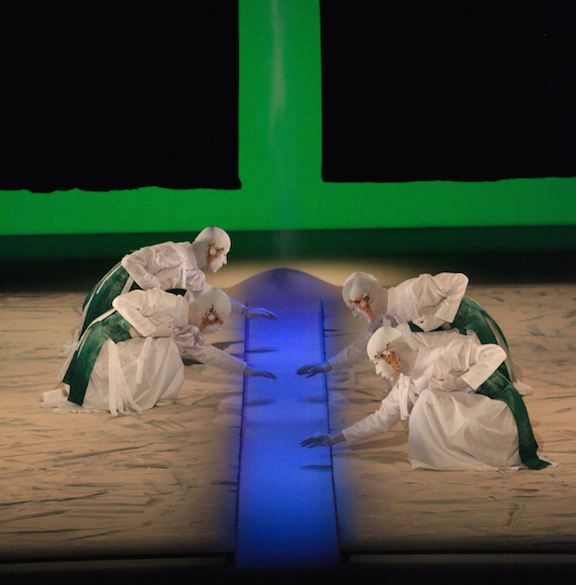
A study in fundamental beauty
When the lights came up again on the stark stage of Yerba Buena Center for the Arts Theater, the audience sighed.
In the center upstage of a nearly dark stage a thin stream of sand poured from the flyspace above the stage. Lit precisely, the sand trembled as it fell, appearing more like a blond wasserfall, surrounded by smoke or mist. The sand, it appeared, marked out time — unstoppable and unending.
Umusuna, by the butoh performance group Sankai Juku, had begun, presented by the sheltering goodness of SF Performances and YBCA.
Downstage center stood choreographer Ushio Amagatsu, in full butoh presence, his body painted white, shaven head and hairless limbs. His off-white robes were folded down around his waist so that his pale torso seemed to rise, naked, from curved petals, the skirt that fell to floor from his hips an exotic flower.
When he moves the gestures are small and precise, but simple, lacking the edge that precision often gives to movement, or the line. In the darkened stage his movements take on an imitative and metaphoric quality. His straightens his fingers, which had been closed in a soft fist, and their glowing lines spring out under the light and resemble buds surging into full bloom.
Lines of red feathers wrap around his ears and fall in a line to the shoulder. They look like streaming blood. And it is here that the power of the piece lies: in these minimal signs that contain within them multiple conflicting and possible meanings. Beauty overlaps with horror, and each time it does it’s as if a new understanding of life – life on a huge scale, a universal scale – comes into being. It partakes of the dark ecstasy of birth, which locks pain into triumph and mystery.
Over the course of the next hour and a half, Amagatsu and the seven dancers that are the performers of Sankai Juku move through the seven sections of Umusuna, which are titled abstractly, poetically: “All that is born,” “Memories from water,” and “Mirror of forests.” The titles tell us this piece is about the physical and natural world. The one held captive by time.
The program notes explain that umusuna is “a very old word originating from ancient Japan that has the same root as ubusuna (one’s place of birth).”
The primary set of the piece was two platforms lightly covered with sand, which rose in clouds as the dancers moved, and two four-foot circles of glass that looked like the dishes in an enormous set of balances and that were individually lowered and raised to indicate the even and the radically uneven temperament that was being portrayed at any one moment. Teardrop-shaped retorts poured sand down on the dishes of the balance.
Behind the waterfall, thin strips of fabric rise and fall, marking out emotional worlds, connecting each to some “place” – forest, river, the far distance. And lights of pure red, yellow, blue and green flood sections of the set, providing a world of primary color through which the pale-skinned humans move.
Are they human? Hard to tell. Their physical bodies seem disconnected from gender or individual features; their blurred specificity transforms them into the preternatural, easily mutable into the elemental world they are recreating.
Despite the abstractness, it was clear the audience never felt at a loss. When the dancers held out their cupped hands under the cobalt blue light running across the middle of the stage, it was clear they were holding the water of a river in their hands.
It was high elegance, but with an eye to the essential. And a revelation in its refined and studied grace.
– Jaime Robles
Photo: SF Performances in collaboration with the Yerba Buena Center for the Arts presented the ravishingly beautiful butoh dance company, Sankai Juku, October 8-11. Photo by Laurent Philippe.
